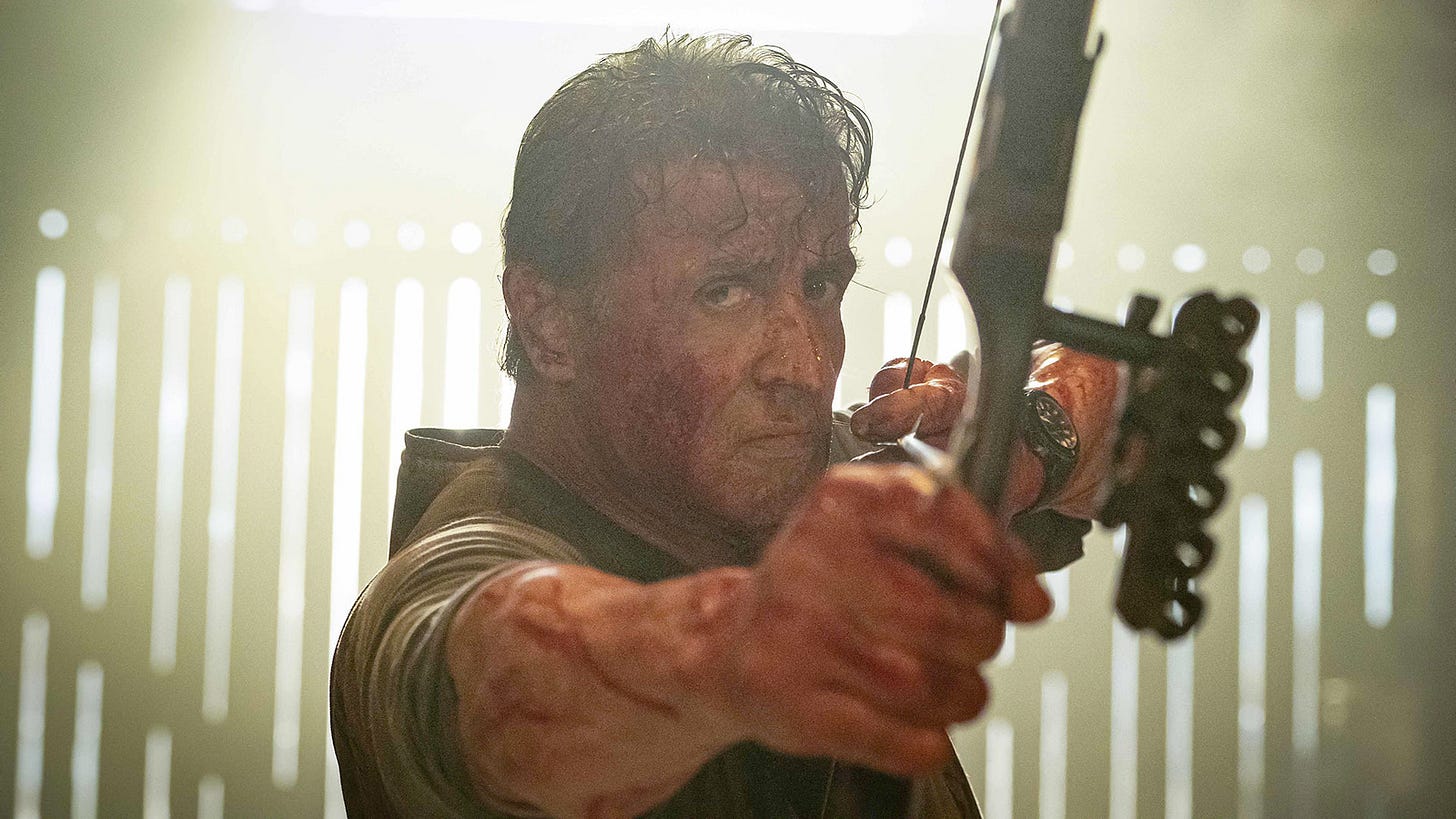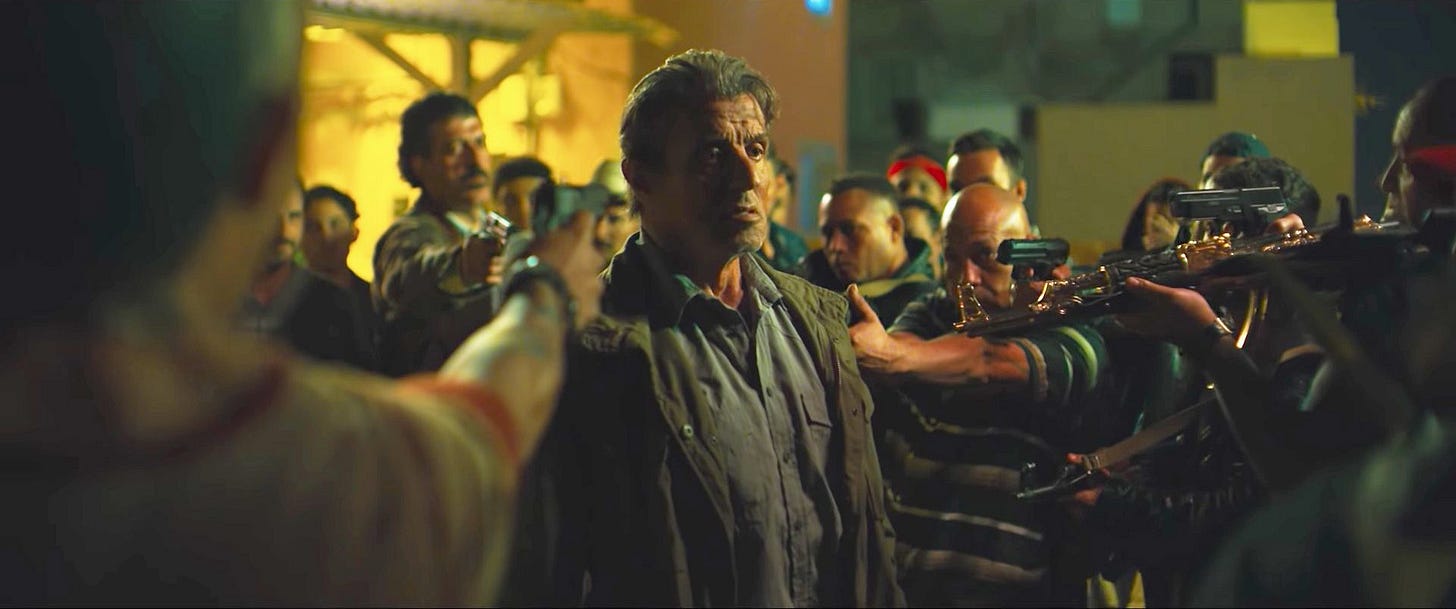The last of the “Rambo” movies, for now, “Rambo: Last Blood” might as well have been written with knuckles. That plays as a recommendation to some of you and a warning to others, and I suppose that’s the way it should be. I never got around to one of the movie’s many basic cable airings when I was in prison, so I was glad to see Sylvester Stallone square up with this franchise one last time at home. And it is as basic and as frills-free as I expected.
At the film’s start, John Rambo has settled into a quiet lifestyle in Arizona, tending to a family ranch – we never did meet the father teased at the end of “Rambo”, it appears he’s dead. He gets by with a Mexican grandmother who gets routine visits from her own granddaughter, leading to a camaraderie between a young millennial and the most infamous cinematic Vietnam vet. She ends up being taken by cartel goons and taken across the border due to (checks notes) Donald Trump’s immigration policies, and at first Rambo’s response is not that of the man who shot people in Burma so hard they exploded in the previous film, “Rambo”. No, it’s more “Gran Torino” – the old guy, going around, asking questions, squinting and scowling but unharmed and hoping for a peaceful resolution.
This approach doesn’t work, though, because this movie is all about the “bad hombres”. Rambo endures a beating no seventy year old would survive and decides to once again, start a war. The optics are… troubling, but this is a franchise that celebrated Rambo saving the Mujahideen from the Russians. It’s all wish fulfillment for the wars we wished we could fight. “First Blood” kind of stands alone as a tale of one shellshocked veteran who goes on a spree of violence that nonetheless only kills a single person, largely in self-defense. Since then, these “Rambo” movies have re-fought Vietnam, tried to puncture the Cold War with bullets, and even saw its hero start and end a civil war in Myanmar.
The implication is that those conflicts are equal in weight to the unrest at the border between American citizens and the cartels sneaking contraband across the border. Which is… not true? It also creates a queasy bookend, in that “First Blood” was about the dignity of those who fought in Vietnam, but “Last Blood” is about slaughtering Mexicans. Your ability to get past this will stem from how much you respect the somehow-still-standing Stallone and his screen presence. He was a dignified old battle axe in “Rambo” all those years back. Now, he’s so elderly it seems like he’s melting, weighed down by too many suns never meant to rise and set over him. His eyes used to sense prey. Now they are lidded, almost closed. The amount of violence he commits in this film justifies its existence for many, but it doesn’t look like Rambo’s really got any more left.
It’s probably best I saw this at home. Seeing this with a prison crowd wouldn’t exactly fill me with a great deal of comfort. This is as close to an exploitation film these movies have gotten. Rambo himself doesn’t seem to have a lot of outspoken rage towards Mexicans in the film proper. But there is a moment where he slaughters his way through a Mexican cathouse, recklessly killing johns who aren’t even attached to the disappearance of the young girl in question. The film never comments on this brief explosion, so the takeaway is one of righteousness. It’s a morally simplistic quest for him to free this kidnapped girl. There is the feeling that director Adrian Grunberg still believes there is simplicity in Rambo killing anyone who might stand in the way. But the aftermath of that massacre comfortably slots Rambo in with other mass murderers of his original era like Jason Voorhees and Leatherface – just arbitrarily on an opposite side.
It’s sort of a reckless movie to come out during an era when the President was demonizing migrants who would cross the border. That’s sort of the spirit of exploitation, and in that regard, it makes sense. But whether or not the idea of Mexican cartels keeps you up at night, the fact is this is the fifth movie in this series that makes it seem as if violence and bloodshed are an answer to a complex question. It plays very strongly to inmates who are not of Mexican heritage, who already have formed gang relationships in direct opposition to the Mexican groups. Racial divisions are strong in prison, and a film like this certainly doesn’t help.
I spoke with a lot of Mexicans when I was down. Many were there in lieu of being sent back home, and they were largely involved in drug charges with gang affiliations. And they clearly had salty feelings towards the then-current (and still-current) way that Mexicans were being looked at by political figures. I knew a group of Mexican guys who routinely played soccer with a ball covered in an illustration of President Trump’s head. The cultural climate was spreading a considerable amount of anger towards these men, and they were eager to release it. I don’t think they can be blamed. But I also don’t think that the exclusionary nature of prison (which typically involves staff members who know not one word of Spanish, a questionable decision given the demographics) is assisting anyone as far as healing racial division. Build bridges, guys.







God, yeah, I still can't bring myself to watch this one. Am I wrong in remebering the 4th "Rambo" as being quite good, though? With an anti-violence message or at least a "it may sometimes be necessary but it's always a tragedy" type of thing? I recall being impressed by that one, but it was quite some time ago.